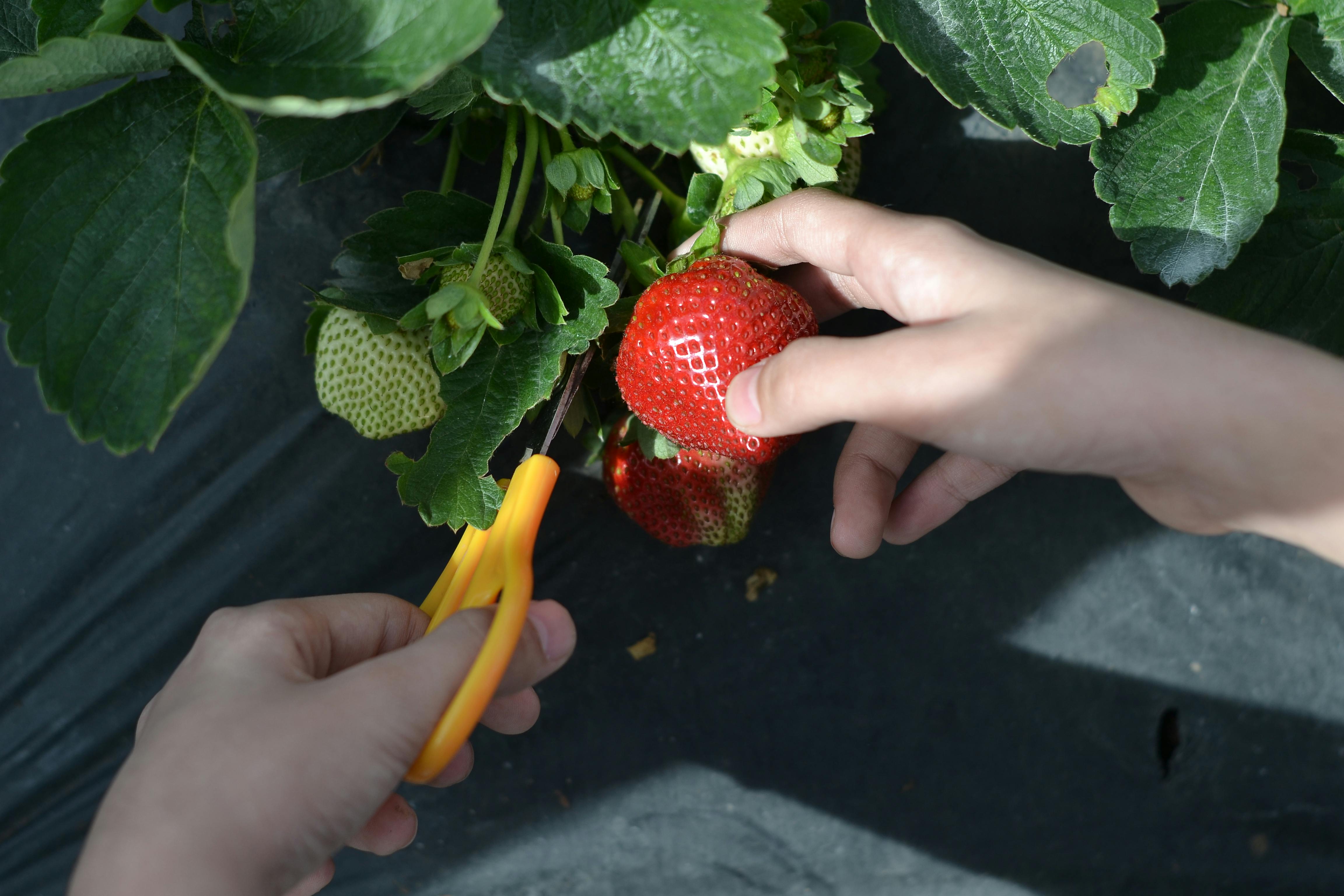One of the most common questions that gardeners have is why their strawberry plant leaves are turning red. While this phenomenon can be alarming, it is important to understand the various causes and solutions available so that you can help restore your plant’s health. In this article, we will discuss why strawberry plant leaves might turn red and how to address the issue.Strawberry plant leaves turn red due to a process known as anthocyanin accumulation. Anthocyanins are a type of flavonoid pigments that are responsible for giving plants their beautiful, vibrant colors. When the strawberry plant is exposed to cold temperatures and/or low light, these pigments accumulate in the leaves, causing them to turn red. This is a natural process that helps protect the plant from environmental damage and may even help it absorb more light for photosynthesis.
Causes of Red Leaves on Strawberry Plants
Red leaves on strawberry plants can be caused by a variety of factors, including nutrient deficiencies, cold temperatures, or disease. Understanding the cause of red leaves can help you take the necessary steps to restore your strawberry plants to health.
Nutrient Deficiency: Nutrient deficiencies in strawberry plants can cause the leaves to turn red. Common nutrient deficiencies include nitrogen, iron and magnesium. Iron deficiency is especially common in sandy soils or those with high pH levels. To determine whether a nutrient deficiency is causing red leaves on your strawberry plant, have your soil tested and apply fertilizer as recommended by the test results.
Cold Temperatures: Colder temperatures can cause strawberry plants to turn reddish-purple in color. If temperatures drop below 40 degrees Fahrenheit, it is best to cover your strawberry plants with a blanket or tarp. This will help protect them from the cold and prevent any further discoloration of the leaves.
Disease: Red leaves on a strawberry plant could also indicate a fungal disease such as botrytis or anthracnose. These diseases are caused by excessive moisture on the foliage due to heavy rain or poor drainage. To help prevent these diseases from occurring, make sure your soil has good drainage and avoid overwatering your plants.
By understanding the causes of red leaves on strawberry plants, you can take steps to restore them to health and ensure that they continue producing delicious berries for many years to come.
Nutrient Deficiencies
Nutrient deficiencies can be quite common, especially if a person is not eating a balanced and nutritious diet. A lack of essential vitamins and minerals can lead to a variety of health problems such as fatigue, poor immune system function, poor digestion, and even anemia. In order to prevent nutrient deficiencies, it is important to eat foods that are rich in the essential minerals and vitamins that the body needs. Eating a balanced diet of fruits, vegetables, whole grains, lean proteins, and healthy fats is an excellent way to ensure that you are getting all the nutrients you need. Supplements can also be used to help fill any gaps in nutrition.
It is important to pay attention to any signs or symptoms of nutrient deficiencies. Common symptoms include fatigue, muscle weakness or cramps, headaches, dizziness, dry skin or hair loss, depression or anxiety. If any of these symptoms occur regularly it is important to speak with a doctor as soon as possible in order to identify any nutrient deficiencies and treat them accordingly. In some cases a simple dietary change may be enough to correct the problem but other times additional supplements may be necessary.
In addition to eating a balanced diet and taking supplements when necessary it is also important to avoid overdoing it with certain vitamins or minerals as this can create an imbalance in the body and cause further issues. It is always best to speak with a doctor before taking any type of supplement so they can provide advice on what your body needs.
Environmental Factors
The environment is an important factor in the health and well-being of people. Environmental factors such as air quality, water quality, and access to safe and healthy foods can all affect health. Poor air quality, for example, can contribute to asthma, heart disease, and other chronic conditions. Unsafe water supplies can lead to outbreaks of infectious diseases. Access to healthy foods is linked to better nutrition and reduced risk of obesity. The availability of green spaces and outdoor activities can also have a positive impact on overall health.
Environmental factors also play a role in mental health. Exposure to stressors such as poverty and violence can increase the risk of developing mental health conditions like depression and anxiety. On the other hand, living in an area with good access to parks or green spaces has been associated with improved mental wellbeing.
Finally, environmental factors can also influence behavior in both positive and negative ways. For example, people living in areas with more green space have been shown to be more physically active than those living in urban areas with less green space. On the other hand, exposure to toxins such as lead can impair cognitive development in children and lead to behavioral problems later on in life.
In conclusion, environmental factors have a major impact on our health and well-being. It is important that we strive for healthier environments so that everyone can benefit from their positive effects on physical health, mental health, and behavior.
Poor Plant Health
Plants are a crucial component of the environment, providing oxygen, absorbing carbon dioxide, and providing food for animals. Poor plant health can lead to a number of problems, including environmental degradation, reduced crop yields, and a decrease in biodiversity. In order to maintain healthy plants, it is important to understand the causes of poor plant health and to take steps to prevent it.
The most common causes of poor plant health are environmental factors such as drought, extreme temperatures, soil contamination, and air pollution. These factors can cause plants to become stressed and can lead to a decrease in their growth rate. Additionally, pests such as insects or diseases can damage or even kill plants if left unchecked.
Fortunately, there are steps that can be taken to prevent poor plant health. These include proper watering techniques, mulching and composting to improve soil quality, using pest-resistant varieties of plants when possible, and controlling air pollution. Additionally, proper fertilization can help ensure that plants have adequate nutrients for growth and development. Finally, regular monitoring for signs of stress or disease can help identify problems before they become too severe.
By taking these steps and understanding the causes of poor plant health, it is possible to maintain healthy plants and ensure a healthy environment for future generations.

Over-Fertilization
Over-fertilization is a common problem in modern agriculture, and it can have serious consequences for the environment and human health. Plants need certain nutrients to grow, but too much of these essential nutrients can be harmful. Over-fertilization leads to excess nutrients entering the environment, which can cause algal blooms, decreased water clarity, and other ecological issues. Excess nutrients also increase the risk of contamination of drinking water sources with toxic chemicals. Furthermore, over-fertilized soil can lead to reduced crop yields and nutrient imbalances in crops that ultimately lead to decreased food quality.
In order to reduce the risk of over-fertilization, farmers should carefully monitor nutrient levels in their soils and adjust their fertilizing practices accordingly. They should also consider using alternative methods of fertilizer application such as slow release fertilizers or incorporating organic matter into their soils. Additionally, farmers should avoid over-watering as this can leach away essential nutrients from the soil. By taking these steps, farmers can help ensure that their crops are getting the optimal amount of nutrients while minimizing environmental damage caused by over-fertilization.
Soil-Borne Diseases and Pests
Soil-borne diseases and pests can cause losses in crop yields, reduce quality of the produce, and even cause a complete loss of the crop. Soil-borne pathogens can be divided into two categories, fungal pathogens and nematodes. Fungal pathogens often cause disease in roots, stems, and leaves by reducing the amount of nutrients available to plants. Nematodes can cause root damage which reduces nutrient uptake and water availability.
It is important for farmers to be aware of soil-borne diseases and pests in order to take preventative measures. Crop rotation is one of the most effective methods for controlling soil-borne diseases and pests as it reduces the risk of re-infection from a previous season’s crop. Additionally, farmers should also practice good sanitation such as removing diseased plants from their fields or using resistant varieties when possible.
Finally, farmers should also monitor their fields for signs of disease or pest infestations. Early detection is key to preventing an outbreak so it is important to regularly check fields for signs of disease or pest activity. If signs are found, farmers should contact their local agricultural extension office for advice on how to proceed with management tactics that are appropriate for their situation.
Red Leaves on Strawberry Plants
Red leaves on strawberry plants can be a cause for concern for any gardener. The cause of red leaves is usually fungal infection, nutrient deficiencies, or environmental stress. Fortunately, there are several solutions that can help prevent the spread of the problem.
Fungal Infection
Fungal infections such as powdery mildew and anthracnose can cause red leaves on strawberry plants. To prevent these fungal diseases, it is important to practice good sanitation and keep the area around the plants free of debris. Additionally, keeping the foliage dry by avoiding overhead watering and using drip irrigation instead will also help reduce the risk of infection.
Nutrient Deficiencies
Red leaves could also be caused by nutrient deficiencies in the soil. To prevent this problem, it is recommended to fertilize your strawberry plants regularly with a balanced fertilizer that contains nitrogen, phosphorus and potassium. Additionally, adding organic matter such as compost or manure to your soil can help improve its quality and boost its nutrient content.
Environmental Stress
Lastly, environmental stress such as high temperatures or too much direct sunlight can also cause red leaves on strawberry plants. To prevent this issue, it is important to provide adequate shade during hot days and ensure that your plants are getting enough water during periods of drought. Additionally, mulching around your strawberry plants will help retain moisture in the soil and reduce the risk of dehydration.
By following these simple steps you should be able to keep your strawberry plants healthy and free from red leaves.

Conclusion
Strawberry plant leaves can turn red for a variety of reasons, including environmental stress, pests, diseases, and nutrient deficiencies. Knowing the cause of the red leaves can help you determine the best solution for your strawberry plants. In most cases, increasing water or fertilizer can help to reduce redness in the leaves. Additionally, controlling pests and diseases can also help to bring your strawberry plant back to health. Finally, make sure that you are providing your plants with adequate light and temperatures as these factors play an important role in the health of strawberry plants.
Overall, it’s important to be aware of why your strawberry plant leaves are turning red so that you can properly address the problem and get your plants back to health. By taking proactive measures such as controlling pests and diseases, providing adequate amounts of water and fertilizer, and monitoring light and temperature levels, you can help ensure that your strawberry plants stay healthy and productive for years to come.



